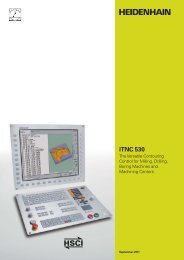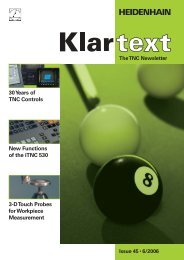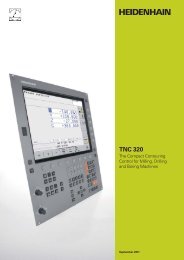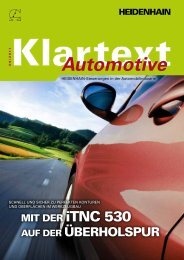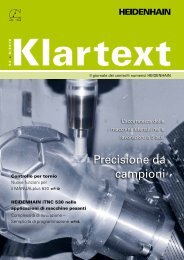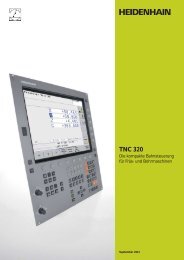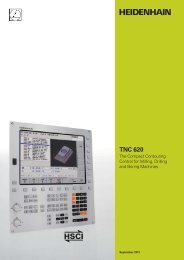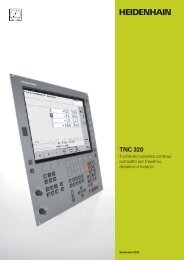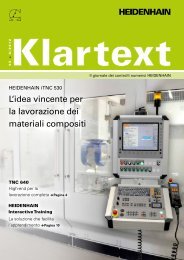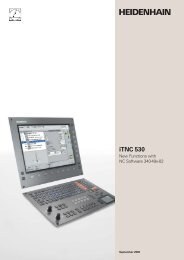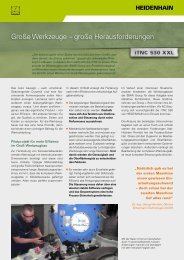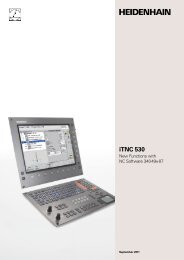Klartext 47 - TNC 640 - Heidenhain
Klartext 47 - TNC 640 - Heidenhain
Klartext 47 - TNC 640 - Heidenhain
You also want an ePaper? Increase the reach of your titles
YUMPU automatically turns print PDFs into web optimized ePapers that Google loves.
1<br />
The <strong>TNC</strong> 620 – The New Contouring<br />
Control from HEIDENHAIN<br />
The new <strong>TNC</strong> 620 adds a compact con-<br />
trol with digital servo drive control to<br />
the range of products from HEIDEN-<br />
HAIN. HEIDENHAIN already introduced<br />
the <strong>TNC</strong> 320, an analog control for simple<br />
3-axis machines, at the EMO 2005,<br />
and it has been proving itself in daily<br />
operation ever since. Both controls are<br />
based on a new, trend-setting software<br />
concept from HEIDENHAIN, and use<br />
the same software platform.<br />
Keep learning instead<br />
of re-learning<br />
HEIDENHAIN controls undergo continuous<br />
improvement, but the basic<br />
operational technique remains the<br />
same. The motto “keep learning instead<br />
of re-learning” is as valid today<br />
as it has always been. This basic premise<br />
was naturally taken into account<br />
for the <strong>TNC</strong> 620: an experienced <strong>TNC</strong><br />
programmer will have absolutely no<br />
problems with the <strong>TNC</strong> 620.<br />
Thanks to the workshop oriented programming<br />
style with helpful dialogs<br />
and graphic support, novices will quickly<br />
feel at home when using the new<br />
control. The clear structure of the soft<br />
keys constantly gives you an overview<br />
of the necessary functions, so that<br />
you can find them immediately. The<br />
keys for initiating typical <strong>TNC</strong> dialogs<br />
are included on the compact keyboard,<br />
so that you can quickly access all <strong>TNC</strong><br />
functions. In addition, the machine<br />
manufacturer can make machine-specific<br />
functions available in the vertical<br />
soft-key row.<br />
Workshop oriented, compact<br />
and trend-settingly digital<br />
Cycles simplify program<br />
creation<br />
The <strong>TNC</strong> 620 features numerous cycles<br />
designed for most machining tasks that<br />
occur on the shop floor. Along with the<br />
machining cycles for drilling, tapping<br />
(with or without floating tap holder),<br />
thread cutting, reaming, and boring,<br />
there are also cycles for hole patterns<br />
(circular and linear). Milling cycles include<br />
facing of flat surfaces, as well as<br />
roughing and finishing pockets, slots<br />
and studs.<br />
Touch-probe cycles, which can easily<br />
be integrated into the machining<br />
program, are available for automatic<br />
measurement and inspection of workpieces.<br />
The <strong>TNC</strong> 620 provides meaningful<br />
support graphics and dialog texts<br />
when the machine operator enters<br />
information for machining or touchprobe<br />
cycles.<br />
When creating workshop-oriented programs<br />
using the tried-and-true conversational<br />
programming language from<br />
HEIDENHAIN, the programming graphics<br />
interactively show step-by-step<br />
what is currently being programmed.<br />
This is especially helpful when using<br />
the powerful free-contour programming<br />
feature to create parts not dimensioned<br />
for NC.<br />
Knowing ahead of time—<br />
thanks to sophisticated<br />
graphics<br />
After completion of an NC program,<br />
the test run graphics can give a realistic<br />
impression of the finished part<br />
before machining begins. The <strong>TNC</strong> also<br />
performs an internal test run to check<br />
the NC program for logical errors, even



